| This article needs additional citations for verification. Please help improve this article by adding citations to reliable sources. Unsourced material may be challenged and removed. Find sources: "Tropical cyclones in 2005" – news · newspapers · books · scholar · JSTOR (September 2020) (Learn how and when to remove this message) |
| This article possibly contains original research. Please improve it by verifying the claims made and adding inline citations. Statements consisting only of original research should be removed. (May 2024) (Learn how and when to remove this message) |
| Tropical cyclones in 2005 | |
|---|---|
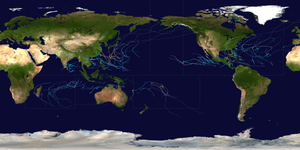 Year summary map Year summary map | |
| Year boundaries | |
| First system | 07 |
| Formed | January 4, 2005 |
| Last system | Zeta |
| Dissipated | January 6, 2006 |
| Strongest system | |
| Name | Wilma |
| Lowest pressure | 882 mbar (hPa); 26.05 inHg |
| Longest lasting system | |
| Name | Kenneth |
| Duration | 16 days |
| Year statistics | |
| Total systems | 130, 6 unofficial |
| Named systems | 94 |
| Total fatalities | 4,459 total |
| Total damage | $181.591 billion (2005 USD) |
| Other years 2003, 2004, 2005, 2006, 2007 | |

Among them, Wilma (third image from the right in the bottom row) was the most intense, with a minimum central pressure of 882 hPa.
During 2005, tropical cyclones formed within seven different tropical cyclone basins, located within various parts of the Atlantic, Pacific and Indian Oceans. During the year, a total of 141 systems formed with 94 of these developing further and were named by the responsible warning centre. The strongest tropical cyclone of the year was Hurricane Wilma, which was estimated to have a minimum barometric pressure of 882 hPa (26.05 inHg). 2005 was above-average in terms of the number of storms. The most active basin in the year was the North Atlantic, which documented 28 named systems. The Western Pacific had an near-average season with 23 named storms. The Eastern Pacific hurricane season experienced an above-average number of tropical storm intensity systems, numbering 15. Activity across the southern hemisphere's three basins – South-West Indian, Australian, and South Pacific – was fairly significant, with the regions recording 23 named storms altogether, with the most intense Southern Hemisphere cyclone of the year, Cyclone Percy from the South Pacific Ocean basin peaking at 145 mph (235 km/h) and 900 millibars. Throughout the year, 28 Category 3 tropical cyclones formed, including eight Category 5 tropical cyclones in the year. The accumulated cyclone energy (ACE) index for the 2005 (seven basins combined), as calculated by Colorado State University was 899.6 units.
The deadliest tropical cyclone of the year was Hurricane Stan in the North Atlantic Ocean, which killed more than 1,600 people in Central America. Hurricane Katrina, also in the North Atlantic Ocean, was the costliest tropical cyclone of the season and all time (tied with Hurricane Harvey in 2017), causing more than $125 billion in damage after striking the United States, especially New Orleans and its surrounding areas.
Global atmospheric and hydrological conditions
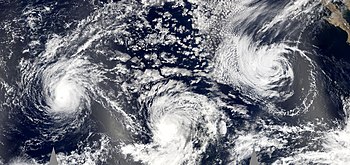
| This section needs expansion. You can help by adding to it. (November 2021) |
The 2005 tropical cyclone season was marked by record-breaking activity, particularly in the North Atlantic, which saw 28 named storms, 15 hurricanes, and 7 major hurricanes, including Hurricane Katrina. This was driven by unusually warm sea surface temperatures, low wind shear, and favorable atmospheric pressure patterns. Globally, the Western Pacific and Indian Oceans experienced near-average activity, while the Eastern Pacific was slightly below average due to cooler waters. The season was shaped by neutral ENSO conditions, warm ocean temperatures, and high ocean heat content, contributing to cyclone intensity in several regions.
A strong La Niña existed throughout 2005.
Summary

North Atlantic Ocean

The activity was the most active Atlantic hurricane season in recorded history at the time, shattering numerous records, with 31 tropical or subtropical cyclones recorded. The United States National Hurricane Center named 27 storms, exhausting the annual pre-designated list and resulting in the usage of six Greek letter names. A record 15 storms attained hurricane status, with maximum sustained winds of at least 74 mph (119 km/h); of those, a record seven became major hurricanes, which are a Category 3 or higher on the Saffir–Simpson scale. The season's impact was widespread and catastrophic. Its storms caused an estimated 3,468 deaths and approximately $171.7 billion in damage. It was the costliest season on record at the time, until its record was surpassed 12 years later. It also produced the second-highest accumulated cyclone energy (ACE) in the Atlantic basin, surpassed only by the 1933 season. The season officially began on June 1, 2005, and the first storm – Arlene – developed on June 8. Hurricane Dennis in July inflicted heavy damage to Cuba. Hurricane Stan in October was part of a broader weather system that killed 1,668 people and caused $3.96 billion in damage to eastern Mexico and Central America, with Guatemala hit the hardest. The final storm – Zeta – formed in late December and lasted until January 6, 2006.
Eastern Pacific Ocean
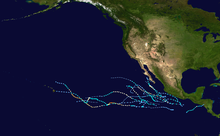
The activity continued the trend of generally below-average activity that began a decade prior. The season's first tropical cyclone, Adrian, developed on May 17 and reached its peak as a Category 1 hurricane. Named storms are infrequent in May, with one tropical storm every two years and a hurricane once every four years. At the time, Adrian was the fourth earliest tropical cyclone to form in the eastern Pacific since reliable record-keeping began in 1971. Activity throughout the remainder of the season was far less notable, with 16 tropical cyclones, 15 named storms, 7 hurricanes, and 2 major hurricanes. The long-term 1971–2004 average suggests an average season to feature 15 named storms, 9 hurricanes, and 4 major hurricanes. October, in particular, was notably quiet, with the formation of only one tropical depression; only three other seasons, 1989, 1995, and 1996, ended the month without the designation of a named storm.
Western Pacific Ocean
| This section does not cite any sources. Please help improve this section by adding citations to reliable sources. Unsourced material may be challenged and removed. (May 2024) (Learn how and when to remove this message) |
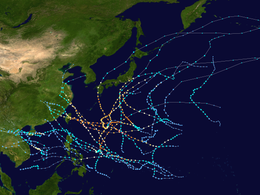
Although the season was quiet, some typhoons caused extensive damages in many places, especially in China where eight typhoons struck the country. First, Typhoon Haitang became the strongest storm in the basin this year and caused about $1.1 billion in damages in Taiwan and China in mid July. In August, Typhoon Matsa made landfall in Eastern China and caused about $2.23 billion in damages. Later that same month, two powerful typhoons made landfall, causing extreme damage and some casualties. Similar to Haitang, Typhoon Longwang made landfall in Taiwan and China at a strong intensity causing damages. The season also marked the first time the Atlantic hurricane season was more active than the Pacific typhoon season (the others being 2010 and 2020). However, the 2005 Atlantic hurricane season featured record high activity while the Pacific typhoon season featured near average activity.
North Indian Ocean
Further information: 2005 North Indian Ocean cyclone season
There were a total of 12 depressions during the year, three less than normal, although the highest since 1992. The IMD named four cyclonic storms, a process they initiated in 2004, which was also below normal. No systems strengthened beyond cyclonic storm status. The season was the sixth in a row with below normal activity, based on the seasonal accumulated cyclone energy. Storms generally develop when the monsoon trough is located over tropical waters, with a peak from May to June and another peak in November. The monsoon developed 11 distinct low-pressure areas by the end of September, including five monsoon depressions, and the monsoon season was more active than usual.
Systems
January
| This section does not cite any sources. Please help improve this section by adding citations to reliable sources. Unsourced material may be challenged and removed. (May 2024) (Learn how and when to remove this message) |
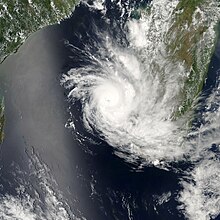
January was above average featuring thirteen tropical cyclones, of which ten of them being named. The month started off with a tropical low which was short lived in the Mozambique Channel. The month's first named storm Cyclone Sally formed on the 7th in the Australian basin, however it dissipated two days later. The South-West Indian Ocean basin also had two notable storms Cyclone Ernest and Tropical Storm Felapi which both impacted Madagascar. The North Indian Ocean had an early start with a depression and Cyclone Hibaru forming. The Northwest Pacific basin also had an early start with Tropical Storm Kulap forming near the Caroline Islands.
| Storm name | Dates active | Max wind mph |
Pressure (hPa) |
Areas affected | Damage (USD) |
Deaths | Refs |
|---|---|---|---|---|---|---|---|
| 07 | January 4–5 | Mozambique, Madagascar | None | None | |||
| Sally | January 7–9 | 95 (60) | 985 | None | None | None | |
| 01B | January 8–10 | 55 (35) | 1000 | None | None | None | |
| Kerry | January 8–14 | 140 (90) | 955 | None | None | None | |
| 10S | January 11–17 | 55 (35) | 998 | None | None | None | |
| Hibaru | January 13–17 | 65 (40) | 1000 | None | None | None | |
| Kulap | January 13–19 | 95 (50) | 985 | Caroline Islands | None | None | |
| Ernest | January 16–23 | 165 (105) | 950 | Madagascar | Minimal | 78 | |
| Daren | January 17–23 | 95 (60) | 986 | None | None | None | |
| Tim | January 23–25 | 85 (50) | 990 | None | None | None | |
| Felapi | January 26 – February 3 | 65 (40) | 995 | Madagascar | None | None | |
| Lola | January 26–February 2 | 75 (45) | 990 | None | None | None | |
| Gerard | January 29 – February 5 | 115 (70) | 973 | None | None | None |
February
| This section does not cite any sources. Please help improve this section by adding citations to reliable sources. Unsourced material may be challenged and removed. (May 2024) (Learn how and when to remove this message) |
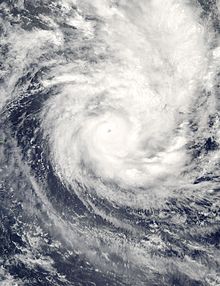
February was slightly below-average featuring nine tropical cyclones, of which seven were named. The Australian region featured Cyclone Harvey and Tropical Low Vivienne. Harvey formed in the Gulf of Carpentaria before making landfall on Queensland and the Northern Territory while Vivienne caused minor oil and gas disruptions in the Timor Sea. The Southern Pacific basin featured seven cyclones of which three of them became Category 5 cyclones. Cyclones Meena, Olaf, Nancy, and Percy all affected the Cook Islands with Percy becoming the strongest storm of the month.
| Storm name | Dates active | Max wind km/h (mph) |
Pressure (hPa) |
Areas affected | Damage (USD) |
Deaths | Refs |
|---|---|---|---|---|---|---|---|
| Meena | February 1–8 | 215 (130) | 915 | Cook Islands | $20 million | None | |
| Harvey | February 3–8 | 140 (90) | 967 | Northern Territory, Queensland | $797 000 | None | |
| Vivienne | February 4–9 | 65 (40) | 990 | None | None | None | |
| Olaf | February 10–20 | 215 (130) | 915 | Samoan Islands, Cook Islands | $10 million | None | |
| Nancy | February 10–17 | 175 (110) | 935 | Samoan Islands, Cook Islands | None | None | |
| Percy | February 24 – March 5 | 230 (145) | 900 | Tokelau, Samoan Islands, Cook Islands | $25 million | None | |
| 11F | February 26–27 | 55 (35) | 998 | French Polynesia | None | None | |
| Rae | February 27 – March 6 | 75 (45) | 990 | None | None | None | |
| 13F | February 27 – March 4 | Not specified | 1001 | None | None | None |
March
| This section does not cite any sources. Please help improve this section by adding citations to reliable sources. Unsourced material may be challenged and removed. (May 2024) (Learn how and when to remove this message) |

March was very inactive, featuring five tropical cyclones with all of them being named. The month started off with Cyclone Ingrid, which formed north of the Gulf of Carpentaria. Ingril was a erratic cyclone which effected much of Northern Australia as a Category 4 tropical storm. The storm made landfall on the town of Nhulunbuy as a Category 5 on the Australian scale. It then made a slow approach on Kimberley before dissipating. While, Ingril was a Category 5 cyclone, another storm named Cyclone Willy formed northwest of Australia. Willy only caused minor oil distruption in the Timor Sea but had no effect on land. The Western Pacific basin featured its second storm Tropical Storm Roke. Roke struck the Philippines as a minimal typhoon killing 7 people. The South-West Indian Ocean featured two storms named Hennie and Isang. Hennie caused minor damage on Mauritius, and Réunion before accelerating towards the southeastern Indian Ocean. Isang on the other hand took a similar route with Hennie but had no effect on land.
| Storm name | Dates active | Max wind km/h (mph) |
Pressure (hPa) |
Areas affected | Damage (USD) |
Deaths | Refs |
|---|---|---|---|---|---|---|---|
| Ingrid | March 4–16 | 230 (140) | 924 | Papua New Guinea, Northern Australia | $14.4 million | 5 | |
| Willy | March 8–14 | 140 (85) | 960 | None | None | None | |
| Roke (Auring) | March 13–19 | 100 (65) | 980 | Caroline Islands, Philippines | $166 thousand | 7 | |
| Hennie | March 19–26 | 100 (65) | 978 | Mauritius, Réunion | None | None | |
| Isang | March 29 – April 6 | 115 (75) | 970 | None | None | None |
April
| This section does not cite any sources. Please help improve this section by adding citations to reliable sources. Unsourced material may be challenged and removed. (May 2024) (Learn how and when to remove this message) |

April was average featuring eight tropical cyclones, of which three were named. The month started off with Cyclone Adeline-Juliet which became the strongest storm of the month. The storm was first noted near the Cocos Islands and was upgraded into Tropical Storm Adeline. It then entered the South-West Indian Ocean basin where the storm was renamed Juliet. It then intensified into an Intense Tropical Cyclone until the system weakened and became extratropical. Later 11U formed over the Arafura Sea and made landfall on Papua New Guinea. 11U was the last storm of the 2004–05 Australian region cyclone season. The second named storm was Cyclone Sheila which formed over Fiji. The storm then curved away from Fiji where the storm dissipated shortly after being named. The third named storm was Typhoon Sonca which formed in the Western Pacific. It then intensified into a Category 4 typhoon. Despite its strength, the typhoon stayed at sea and dissipated. The other unnamed storms were rather weak and short-lived as not much information is known.
| Storm name | Dates active | Max wind km/h (mph) |
Pressure (hPa) |
Areas affected | Damage (USD) |
Deaths | Refs |
|---|---|---|---|---|---|---|---|
| Adeline–Juliet | April 2–11 | 220 (140) | 905 | Cocos (Keeling) Islands | Minimal | None | |
| 11U | April 13–15 | Not specified | 990 | Papua New Guinea | None | None | |
| 14F | April 14 – May 1 | 55 (35) | 1000 | None | None | None | |
| Sheila | April 20–22 | 75 (45) | 990 | Fiji | None | None | |
| 16F | April 20–22 | Not specified | 1000 | Niue | None | None | |
| Sonca (Bising) | April 21–27 | 165 (105) | 935 | Caroline Islands | None | None | |
| 17F | April 26 – May 1 | Not specified | 1007 | None | None | None | |
| 18F | April 29 – May 1 | Not specified | 1006 | None | None | None |
May
| This section does not cite any sources. Please help improve this section by adding citations to reliable sources. Unsourced material may be challenged and removed. (May 2024) (Learn how and when to remove this message) |
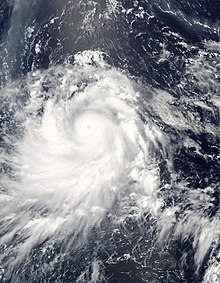
May was a very inactive season featuring only three tropical cyclones with two of them being named. The month's first storm started in the Western Pacific with the formation of a tropical depression named Crising which was named by the PAGASA. Crising formed east of the Philippine island of Mindanao however, the storm never organized into a tropical storm and did not receive an International name. It then dissipated east of the Philippines. The Eastern Pacific featured its first storm of the year, Hurricane Adrian. Adrian formed very early shortly after the season started and took an unusually northeast route towards El Salvador making it the closest hurricane ever to approach the country. It then made landfall on Honduras before dissipating. The last storm of the month was Nesat which formed near Guam. Nesat then intensified into a Category 4 typhoon before passing south of Japan before becoming extratropical southeast of Japan.
| Storm name | Dates active | Max wind km/h (mph) |
Pressure (hPa) |
Areas affected | Damage (USD) |
Deaths | Refs |
|---|---|---|---|---|---|---|---|
| Crising | May 15–18 | 55 (35) | 1004 | Philippines | None | None | |
| Adrian | May 17–21 | 130 (80) | 982 | El Salvador, Guatemala, Honduras, Nicaragua | $12 million | 5 | |
| Nesat (Dante) | May 27 – June 11 | 175 (110) | 930 | Caroline Islands, Japan, Philippines | None | None |
June
| This section does not cite any sources. Please help improve this section by adding citations to reliable sources. Unsourced material may be challenged and removed. (May 2024) (Learn how and when to remove this message) |

June was an inactive month featuring only six tropical storms with four of them being named. The Eastern Pacific featured Tropical Storm Calvin which formed south of Mexico. However, the storm weren't much of a threat to the country. The Atlantic featured Tropical Storm Arlene and Tropical Storm Bret. Arlene, which became the first storm of the 2005 Atlantic hurricane season and the strongest storm of the month, formed very early north of Honduras. It traveled north in the Gulf of Mexico then made landfall near the Alabama-Florida border. Bret was a short lived storm that made landfall Veracruz in Mexico causing minor damage. The North Indian Ocean featured two depressions with one depression forming over India causing minor flooding.
| Storm name | Dates active | Max wind km/h (mph) |
Pressure (hPa) |
Areas affected | Damage (USD) |
Deaths | Refs |
|---|---|---|---|---|---|---|---|
| Arlene | June 8–13 | 110 (70) | 989 | Cayman Islands, Cuba, Florida | $11.8 million | 1 | |
| ARB 01 | June 21–22 | 45 (30) | 992 | Gujarat | None | None | |
| Beatriz | June 21–24 | 85 (50) | 1000 | None | None | None | |
| Calvin | June 26–29 | 85 (50) | 1000 | Mexico | Minimal | None | |
| LAND 01 | June 27 – July 5 | 45 (30) | 990 | India | Unknown | 26 | |
| Bret | June 28–30 | 65 (40) | 1002 | Mexico | $9.2 million | 2 |
July
| This section does not cite any sources. Please help improve this section by adding citations to reliable sources. Unsourced material may be challenged and removed. (May 2024) (Learn how and when to remove this message) |
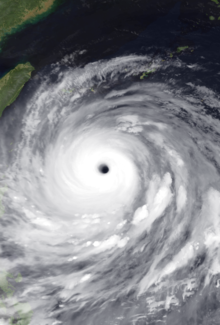
July was average featuring fourteen tropical cyclones, with twelve of them being named. The East Pacific featured two tropical storms named Dora and Eugene. The two storms made a close approach to the Mexican coastline however, the damage was minimal. The Western Pacific saw the formation of Typhoons Haitang, Matsa and Tropical Storms Nalgae, Banyan, and Washi and Emong. Typhoon Haitang, which became the strongest storm of the month made landfall on China and Taiwan along with Typhoon Matsa which made landfall near Shanghai. Washi made landfall in Vietnam while Banyan made a close approach to Japan but missed the country and became extratropical east of Japan. The Atlantic featured three hurricanes and two tropical storms. Some notable storms include Dennis and Hurricane Emily. Dennis was an early-forming Category 4 hurricane that traveled across the Caribbean and eventually striking Alabama inflicting severe damage and killing at least 70 people. Dennis was then followed by Emily which also formed near Windward Islands. It then became the earliest-forming hurricane with a Category 5 strength. It was also the costliest Category 5 hurricane to not have its name retired. The North Indian Ocean featured the only non-named storm of the month classified as BOB 02 which was short lived.
| Storm name | Dates active | Max wind km/h (mph) |
Pressure (hPa) |
Areas affected | Damage (USD) |
Deaths | Refs |
|---|---|---|---|---|---|---|---|
| Cindy | July 3–7 | 120 (75) | 991 | Yucatán Peninsula, East Coast of the United States | $320 million | 3 | |
| Dora | July 4–6 | 75 (45) | 1002 | Mexico | Minimal | None | |
| Dennis | July 4–13 | 240 (150) | 930 | Windward Islands, Greater Antilles, Gulf Coast of the United States, Great Lakes region | $4.26 billion | 88 | |
| Emong | July 4–7 | Not specified | 1004 | Philippines China | None | None | |
| Haitang (Feria) | July 10–21 | 195 (120) | 920 | Mariana Islands, Ryukyu Islands, Taiwan, China | $1.1 billion | 13 | |
| Emily | July 11–21 | 260 (160) | 929 | Lesser Antilles, Greater Antilles, South America, Yucatán Peninsula, Mexico, Texas | $1.01 billion | 17 | |
| Eugene | July 18–20 | 110 (70) | 989 | Baja California Peninsula | Minimal | 1 | |
| Nalgae | July 18–24 | 85 (50) | 990 | None | None | None | |
| Banyan | July 20–27 | 100 (65) | 975 | Japan | None | None | |
| Franklin | July 21–29 | 110 (70) | 997 | The Bahamas, Bermuda, Newfoundland and Labrador | None | None | |
| Gert | July 23–25 | 75 (45) | 1005 | Central America | $6 million | 1 | |
| Washi | July 28–31 | 85 (50) | 985 | China, Vietnam | None | None | |
| BOB 02 | July 29–31 | 55 (35) | 988 | India | Unknown | 1 | |
| Matsa (Gorio) | July 30 – August 8 | 150 (90) | 950 | Taiwan, China, Korea | $2.23 billion | 29 |
August
| This section does not cite any sources. Please help improve this section by adding citations to reliable sources. Unsourced material may be challenged and removed. (May 2024) (Learn how and when to remove this message) |
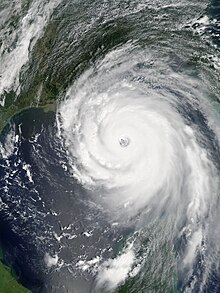
August was average, featuring eighteen tropical cyclones with fourteen of them being named. The Eastern Pacific featured Hurricanes Fernanda, and Hilary, Tropical Storms Greg, and Irwin along with one depression classified as One-C. The five storms all stayed away from any landmass however, One-C's remnants dropped moderate rain on Hawaii causing minor damage. The Western Pacific featured three typhoons named Mawar, Talim, and Nabi and Severe Tropical Storms Sanvu and Ghuchol. Sanvu and Talim struck China while Mawar and Nabi affected Japan. The Atlantic featured Tropical Storms Harvey, Jose, and Lee and Hurricanes Irene and Katrina. Jose was short lived but struck Central Mexico causing minor damage. Hurricane Katrina on the other hand struck Florida and intensified into the season's second Category 5 hurricane. Katrina then struck New Orleans causing a large storm surge leaving the city completely flooded. The hurricane killed at least 1,800 people and inflicted $125 billion dollars worth of damage making it at the time the costliest tropical storm on record until it tied with Hurricane Harvey in 2017.
| Storm name | Dates active | Max wind km/h (mph) |
Pressure (hPa) |
Areas affected | Damage (USD) |
Deaths | Refs |
|---|---|---|---|---|---|---|---|
| Harvey | August 2–8 | 100 (65) | 994 | Bermuda | None | None | |
| One-C | August 3–4 | 45 (30) | 1008 | None | None | None | |
| Irene | August 4–18 | 165 (105) | 970 | East Coast of the United States | None | 1 | |
| TD | August 9–12 | Not specified | 996 | China, Vietnam, Laos | None | None | |
| Fernanda | August 9–16 | 140 (85) | 978 | None | None | None | |
| Sanvu (Huaning) | August 9–14 | 95 (60) | 985 | Philippines Taiwan, China | None | None | |
| Greg | August 11–15 | 85 (50) | 1000 | None | None | None | |
| Ten | August 13–14 | 55 (35) | 1008 | None | None | None | |
| Ghuchol | August 18–25 | 100 (65) | 980 | None | None | None | |
| Mawar | August 19–27 | 175 (110) | 930 | Japan | None | 2 | |
| Hilary | August 19–25 | 165 (105) | 970 | None | None | None | |
| Jose | August 22–23 | 95 (65) | 998 | Mexico | $45 million | 16 | |
| Katrina | August 23–30 | 280 (175) | 902 | The Bahamas, Florida, Gulf Coast of the United States | $125 billion | 1,836 | |
| Irwin | August 25–28 | 85 (50) | 1000 | Mexico | None | None | |
| Talim (Isang) | August 25 – September 2 | 175 (110) | 925 | Taiwan, China | $1.5 billion | 150 | |
| TD | August 27–31 | Not specified | 1000 | China, Vietnam, Laos | None | None | |
| Lee | August 28 – September 3 | 65 (40) | 1006 | None | None | None | |
| Nabi (Jolina) | August 28 – September 8 | 175 (110) | 925 | Caroline Islands, Mariana Islands, Korea, Japan, Russia, Alaska | $972 million | 35 |
September
| This section does not cite any sources. Please help improve this section by adding citations to reliable sources. Unsourced material may be challenged and removed. (May 2024) (Learn how and when to remove this message) |
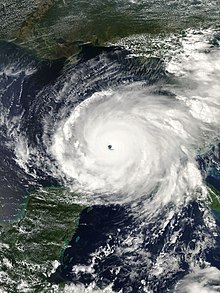
September was very active featuring 22 tropical storms with 17 of them being named. The Eastern Pacific featured Hurricanes Jova, Kenneth, Max, and Otis and Tropical storms Lidia and Norma. Otis became a Category 2 hurricane and threatened the Baja California Peninsula, however, it dissipated before it could reach the peninsula. The other storms on the other hand stayed at sea. The Western Pacific featured some deadly storms mostly being Typhoons Khanun, Damrey, Vicente, and Longwang. Khanun, Damrey, and Longwang all struck China killing more than 350 people. Vincente on the other hand looped in The South China Sea before striking Vietnam killing at least 22 people. The Atlantic season continued with the formation of Hurricanes Maria, Nate, Ophelia, Philippe, and Rita, and a short lived depression. Maria, affected parts of Norway causing 3 deaths. Nate stayed at sea however it disturbed some Canadian Navy ships heading to the U.S to help in the aftermath of Hurricane Katrina along with Ophelia which affected much of the Eastern United States as well as parts of Atlantic Canada. Hurricane Rita on the other hand became the third Category 5 hurricane in the basin and became the most intense Atlantic Hurricane in the Gulf of Mexico by pressure. Rita then made landfall near the Texas-Louisiana border which was already devastated by Hurricane Katrina. Rita was the strongest storm in 2005 until it was then beaten by Hurricane Wilma the next month. In the North Indian Ocean, three short lived depressions as well as Cyclone Pyarr formed. Pyarr, being the only named stormed of the month affected India and Bangladesh which resulted in severe damage and severe loss of life.
| Storm name | Dates active | Max wind km/h (mph) |
Pressure (hPa) |
Areas affected | Damage (USD) |
Deaths | Refs |
|---|---|---|---|---|---|---|---|
| Maria | September 1–10 | 185 (115) | 962 | Northeastern United States, Iceland, Scotland, Norway | $3.1 million | 3 | |
| Nate | September 5–10 | 150 (90) | 979 | Bermuda, Azores | None | 1 | |
| Ophelia | September 6–17 | 140 (85) | 976 | The Bahamas, Florida, East Coast of the United States, Atlantic Canada, Europe | $70 million | 3 | |
| Khanun (Kiko) | September 6–12 | 155 (100) | 945 | Caroline Islands, Taiwan, China, Korea | $1.22 billion | 16 | |
| TD | September 11–14 | Not specified | 998 | Vietnam, Cambodia, Thailand | None | None | |
| Jova | September 12–25 | 205 (125) | 951 | None | None | None | |
| BOB 03 | September 12–16 | 45 (30) | 992 | India | Unknown | 6 | |
| ARB 02 | September 14–16 | 45 (30) | 996 | Gujarat | Unknown | 13 | |
| Kenneth | September 14–30 | 215 (130) | 947 | Hawaii | None | None | |
| TD | September 15–16 | Not specified | 1004 | Philippines | None | None | |
| Vicente | September 16–19 | 85 (50) | 985 | Philippines, China, Vietnam, Laos, Thailand | $3.48 million | 22 | |
| Philippe | September 17–23 | 130 (80) | 986 | Bermuda | Minimal | None | |
| Lidia | September 17–19 | 65 (40) | 1005 | None | None | None | |
| Pyarr | September 17–21 | 65 (40) | 988 | India, Bangladesh | $11.4 million | 84 | |
| Max | September 18–22 | 140 (85) | 981 | None | None | None | |
| Rita | September 18–26 | 285 (180) | 895 | Hispaniola, The Bahamas, Cuba, Florida, Gulf Coast of the United States, Midwestern United States | $18.5 billion | 120 | |
| Saola | September 19–26 | 150 (90) | 950 | Japan | None | None | |
| Damrey (Labuyo) | September 19–28 | 150 (90) | 955 | Philippines Taiwan, China, Vietnam, Laos, Thailand | $1.73 billion | 180 | |
| Norma | September 23–27 | 95 (60) | 997 | None | None | None | |
| Longwang (Maring) | September 25 – October 3 | 175 (110) | 930 | Ryukyu Islands, Taiwan, China | $970.5 million | 149 | |
| Otis | September 28 – October 3 | 165 (105) | 970 | Baja California Peninsula | Minimal | None | |
| Nineteen | September 30 – October 2 | 55 (35) | 1006 | None | None | None |
October
| This section does not cite any sources. Please help improve this section by adding citations to reliable sources. Unsourced material may be challenged and removed. (May 2024) (Learn how and when to remove this message) |
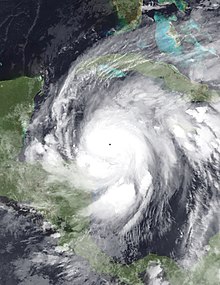
October was above average featuring sixteen storms with eight of them being named. In the East Pacific a short lived depression formed. The storm officially ended the 2005 Pacific hurricane season. In the West Pacific, Typhoons Kirogi and Kai-tak along with three depressions formed. Kirogi approached Japan but drifted away from the mainland. Kai-tak on the other hand paralleled the Vietnamese coast as a tropical storm before dissipating. In the Atlantic, the active season continued on with the formation of Tropical Storms Tammy and Alpha and, Hurricanes Stan, Vince, Wilma, Beta and along with two depressions and an unnamed subtropical storm. Stan affected much of Central America and Mexico killing more than 1,600 people. Vince formed out of the unnamed subtropical storm which then intensified into a minimal Category 1 hurricane becoming the most eastern hurricane until the record was broken by Hurricane Pablo in 2019. Hurricane Wilma on the other hand intensified into a Category 5 hurricane within a day with its pressure dropping from 982hPa to 882hPa within a 30-hour period. Wilma became the most intense Atlantic hurricane ever recorded, based on pressure. In the North Indian Ocean, 03B and BOB 04 formed but were short lived.
| Storm name | Dates active | Max wind km/h (mph) |
Pressure (hPa) |
Areas affected | Damage (USD) |
Deaths | Refs |
|---|---|---|---|---|---|---|---|
| Stan | October 1–5 | 130 (80) | 977 | Central America, Mexico | $2.70 billion | 1,669 | |
| 03B | October 1–3 | 75 (45) | 994 | India, Bangladesh | Unknown | 16 | |
| Unnamed | October 4–5 | 85 (50) | 997 | Azores | None | None | |
| Tammy | October 5–6 | 85 (50) | 1001 | The Bahamas, Florida | $30 million | 10 | |
| 20W | October 6–8 | Not specified | 1006 | Vietnam, Cambodia, Laos | None | None | |
| Twenty-Two | October 8–10 | 55 (35) | 1008 | Bermuda, New England | Minimal | None | |
| Vince | October 8–11 | 120 (75) | 988 | Madeira Island, Portugal, Spain | Minimal | None | |
| TD | October 7–17 | Not specified | 1004 | None | None | None | |
| Kirogi (Nando) | October 9–19 | 185 (115) | 930 | None | None | None | |
| TD | October 10–12 | Not specified | 1004 | None | None | None | |
| Wilma | October 15–26 | 185 (295) | 882 | Jamaica, Central America, Yucatán Peninsula, Cuba, Florida, The Bahamas, Atlantic Canada | $27.4 billion | 52 | |
| Sixteen-E | October 15–20 | 55 (35) | 1005 | None | None | None | |
| Alpha | October 22–24 | 85 (50) | 998 | Hispaniola, The Bahamas | Unknown | 26 | |
| BOB 04 | October 26–29 | 55 (35) | 998 | India | Unknown | 105 | |
| Beta | October 26–31 | 185 (115) | 962 | Central America, Colombia | $15.5 million | 9 | |
| Kai-tak | October 28 – November 2 | 150 (90) | 950 | Vietnam, China | $11 million | 19 |
November
| This section does not cite any sources. Please help improve this section by adding citations to reliable sources. Unsourced material may be challenged and removed. (May 2024) (Learn how and when to remove this message) |

November was average featuring ten storms with seven storms being named. In the Southern Hemisphere, 02R and 01F formed but were short lived. Another notable storm was Cyclone Bertie-Alvin which was given two names. Bertie-Alvin wandered across the Southern Indian Ocean before dissipating. In the West Pacific, Tembin and Bolaven formed with the storms affecting the Philippines. In the North Indian Ocean, BOB 05 and Cyclone Baaz. In the Atlantic, Tropical storms Gamma, Delta and Hurricane Epsilon formed. Gamma affected Central America while Epsilon stayed out to sea. Delta, on the other hand, stuck the Canary Islands which destroyed an iconic sea stack. Delta's remnants then made landfall of Morocco and Algeria.
| Storm name | Dates active | Max wind km/h (mph) |
Pressure (hPa) |
Areas affected | Damage (USD) |
Deaths | Refs |
|---|---|---|---|---|---|---|---|
| 02R | November 5–8 | 55 (35) | 995 | None | None | None | |
| Tembin (Ondoy) | November 7–12 | 65 (40) | 1002 | Caroline Islands, Philippines | None | None | |
| Bolaven (Pepeng) | November 14–20 | 100 (65) | 985 | Philippines | None | None | |
| Gamma | November 14–21 | 85 (50) | 1002 | Lesser Antilles, Central America | $18 million | 39 | |
| BOB 05 | November 20–22 | 45 (30) | 1002 | Sri Lanka, India | None | None | |
| Delta | November 22–28 | 110 (70) | 980 | Canary Islands, North Africa, (Especially Algeria and Morocco) | $362 million | 19 | |
| Bertie-Alvin | November 19 – December 3 | 185 (115) | 928 | None | None | None | |
| Baaz | November 28 – December 2 | 85 (50) | 998 | Thailand, India | $11 million | 22 | |
| Epsilon | November 29 – December 8 | 140 (85) | 981 | None | None | None | |
| 01F | November 30 – December 2 | Not specified | 1004 | None | None | None |
December
| This section does not cite any sources. Please help improve this section by adding citations to reliable sources. Unsourced material may be challenged and removed. (May 2024) (Learn how and when to remove this message) |

December was inactive featuring six storms with two of them being named. In the Southern Hemisphere, 02F and 04R formed but were short lived. In the West Pacific, a short lived depression that was named Quedan by the PAGASA traveled across the South China Sea and dissipated south of Vietnam. In the North Indian Ocean, Cyclonic Storm Fanoos and BOB 08 formed with Fannos making landfall in Southern India. BOB 08 on the other hand stayed in the Bay of Bengal. In the Atlantic, Zeta formed very late in the season and became the 28th storm of the year. Zeta continued into January 2006 which made it the second Atlantic tropical cyclones to span two calendar years (the other being Hurricane Alice in 1954–55).
| Storm name | Dates active | Max wind km/h (mph) |
Pressure (hPa) |
Areas affected | Damage (USD) |
Deaths | Refs |
|---|---|---|---|---|---|---|---|
| 02F | December 3–6 | Not specified | 1002 | None | None | None | |
| Fanoos | December 6–10 | 85 (50) | 998 | India, Sri Lanka | Unknown | None | |
| BOB 08 | December 15–22 | 55 (36) | 1000 | India | None | None | |
| 25W (Quedan) | December 16–22 | 55 (35) | 1000 | Philippines Vietnam | None | None | |
| 04R | December 21–23 | 55 (35) | 998 | None | None | None | |
| Zeta | December 30 – January 6 | 100 (65) | 994 | None | None | None |
Global effects
- The sum of the number of systems and fatalities in each basin will not equal the number shown as the total. This is because when systems move between basins, it creates a discrepancy in the actual number of systems and fatalities.
See also
Notes
- The United States National Hurricane Center is the official Regional Specialized Meteorological Center for the North Atlantic basin.
Only systems that formed either on or after January 1, 2005 are counted in the seasonal totals.
Only systems that formed either before or on December 31, 2005 are counted in the seasonal totals.
The wind speeds for this tropical cyclone/basin are based on the IMD Scale which uses 3-minute sustained winds.
The wind speeds for this tropical cyclone/basin are based on the Saffir Simpson Scale which uses 1-minute sustained winds.
The wind speeds for this tropical cyclone are based on Météo-France which uses gust winds.
References
- Worldwide Tropical Cyclone Centers (Report). National Hurricane Center. 2011-09-11. Archived from the original on March 21, 2015. Retrieved March 19, 2020.
- Richard D. Knabb; James L. Franklin (June 1, 2005). Monthly Tropical Weather Summary: May (Report). Miami, Florida: National Hurricane Center. Retrieved April 25, 2017.
- Stacy R. Stewart; John L. Beven II; James L. Franklin (November 1, 2005). Monthly Tropical Weather Summary: October (Report). National Hurricane Center. Retrieved April 27, 2017.
- H.J. Diamond; K.A. Shein (June 2006). "The Tropics" (PDF). Bureau of the American Meteorological Society. Retrieved 2015-06-30.
- Government of India (2005-10-05). "India Meteorological Department southwest monsoon 2005 end-of-season report". ReliefWeb. Retrieved 2015-06-30.
External links
| Tropical cyclone year articles (2000–2009) |
|---|
| 2000, 2001, 2002, 2003, 2004, 2005, 2006, 2007, 2008, 2009 |
Regional Specialized Meteorological Centers
- US National Hurricane Center – North Atlantic, Eastern Pacific
- Central Pacific Hurricane Center – Central Pacific
- Japan Meteorological Agency – NW Pacific
- India Meteorological Department – Bay of Bengal and the Arabian Sea
- Météo-France – La Reunion – South Indian Ocean from 30°E to 90°E
- Fiji Meteorological Service – South Pacific west of 160°E, north of 25° S
Tropical Cyclone Warning Centers
- Meteorology, Climatology, and Geophysical Agency of Indonesia – South Indian Ocean from 90°E to 141°E, generally north of 10°S
- Australian Bureau of Meteorology (TCWC's Perth, Darwin & Brisbane) – South Indian Ocean & South Pacific Ocean from 90°E to 160°E, generally south of 10°S
- Papua New Guinea National Weather Service – South Pacific Ocean from 141°E to 160°E, generally north of 10°S
- Meteorological Service of New Zealand Limited – South Pacific west of 160°E, south of 25°S
![]() This article incorporates public domain material from websites or documents of the National Weather Service.
This article incorporates public domain material from websites or documents of the National Weather Service.
| Tropical cyclones in 2005 | |
|---|---|
| Cyclones | |
| Hurricanes | |
| Typhoons | |
| Non-seasonal lists | |